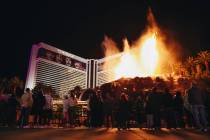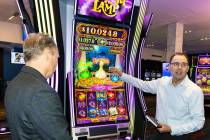Analysts expect Strip rebound to continue in 2015


Gaming industry predictions are not exact science.
A year ago there wasn’t an analyst who thought Macau’s casino market would see its first annual gaming revenue decrease in 2014.
Atlantic City was easy to predict. Most gaming observers correctly said the Boardwalk would suffer through its eighth straight annual revenue decline, although no one anticipated four casinos would be closed by December.
Slot machine industry consolidation, with International Game Technology, Bally Technologies and Multimedia Games swallowed up in buyouts, also didn’t appear on the horizon.
“To say 2014 was an interesting year in our coverage universe would be a bit of an understatement,” Stifel Nicolaus Capital Markets gaming analyst Steven Wieczynski said this month.
So what’s ahead for 2015?
Analysts believe the Strip will continue its rebound, although gaming won’t be the primary reason.
Nongaming spending by customers continues to outpace casino revenue. The trend never will be reversed.
According to the Gaming Control Board’s recently published Fiscal 2014 Gaming Abstract, Strip casinos increased total revenue by 5 percent, to $16.3 billion. Gaming revenue of $5.99 billion — 36.7 percent of the overall figure — was up 4.2 percent over fiscal 2013.
Gaming revenue, however, is still down 7.7 percent from its peak of $6.5 billion in fiscal 2007.
The Strip’s nongaming amenities didn’t mirror gaming’s result.
Hotel rooms on the Strip brought in $4.25 billion in revenue in fiscal 2014; restaurants accounted for $2.51 billion; alcohol sales topped $1.2 billion; and other areas — nightclubs, retail and entertainment — had revenue of $2.35 billion.
All four categories experienced 12-month record revenue totals.
No one should be surprised. Gaming’s contribution to the overall financial health of the Strip has been less than half since 1998. The average split of 60-40 between nongaming revenue and gaming revenue has been the trend on the Strip since the mid-2000s.
The spread could increase when fiscal 2015 is in the books.
Las Vegas visitation, expected to top a record 41.1 million tourists in calendar year 2014, is predicted to grow by another 500,000 travelers in 2015. Conventions already booked for 2015 are projected to attract 15,000 more attendees than a year ago.
The visitors also will have more attractions to occupy their time away from the casino.
Caesars Entertainment Corp.’s Linq retail, dining and entertainment development is fully open. Revenue from every ride on the High Roller observation wheel goes in the “other areas” category.
MGM Resorts International opened several restaurants associated with its Park development between New York-New York and Monte Carlo this month. More nongaming aspects of the Park will come this year, ahead of the 20,000-seat sports arena, which will anchor the Park, in 2016.
The company also will unveil its Rock in Rio outdoor music festival grounds on the north end of the Strip in May.
Meanwhile, other Strip resorts are adding new nightclubs and remodeling restaurants. The Cromwell and SLS Las Vegas, heavy with restaurants and nightclubs, opened last summer.
As for gaming, the evidence is clear that high-end baccarat play kept the Strip’s gaming results alive after the recession hit and the recovery began.
In calendar 2012, casinos grew overall gaming revenue by 2.3 percent. Baccarat revenue increased 8.7 percent that same year. In calendar 2013, the Strip saw gaming revenue jump 4.8 percent, but baccarat revenue climbed 16.6 percent, to a record $1.59 billion.
When calendar 2014 is in the books, it’s expected that Strip gaming revenue will show a 1 percent decline. Baccarat is expected to be off by 4.5 percent.
“The gaming recovery of the Strip has been dependent on baccarat play and may continue to do so,” Deutsche Bank gaming analyst Andrew Zarnett told investors this month.
So which company benefits?
Analysts are bullish on MGM Resorts, but not because of baccarat.
The company operates 10 Strip properties, including CityCenter, MGM Grand, The Mirage and Mandalay Bay, encompassing 41,000 hotel rooms and two large convention complexes.
Zarnett said cash flow from the company’s flagship Bellagio are just 5 percent off the property’s 2007 peak, the best result he has seen on the Strip.
Wieczynski told investors that shares of MGM Resorts, traded on the New York Stock Exchange, will see the best boost in value of any gaming company if current trends continue.
“MGM’s Strip returns have also benefited from judicious cost management, which has allowed modest top-line gains to generate outsized cash flow growth,” Wieczynski said.
MGM Resorts also is expanding in Macau, adding the $2.9 billion MGM Cotai. The resort is expected to open in 2016. Most analysts believe Macau will stage a comeback starting in the second half of this year.
Wieczynski said the MGM Macau, which opened in 2007, “makes the most of the market’s current realities,” operating just 9 percent of the overall table games in the region. The Cotai resort will double MGM’s footprint in Macau.
“The greatest value lies in its ability to grow MGM’s share of the market’s nongaming business, the segment we expect to deliver superior return in the years ahead,” Wieczynski said.
He said Macau will transition “from a gambling enclave into a total entertainment destination.”
The predictions already are starting for 2016.
Howard Stutz’s Inside Gaming column appears Wednesdays and Sundays. He can be reached at hstutz@reviewjournal.com or 702-477-3871. Follow on Twitter: @howardstutz.


















